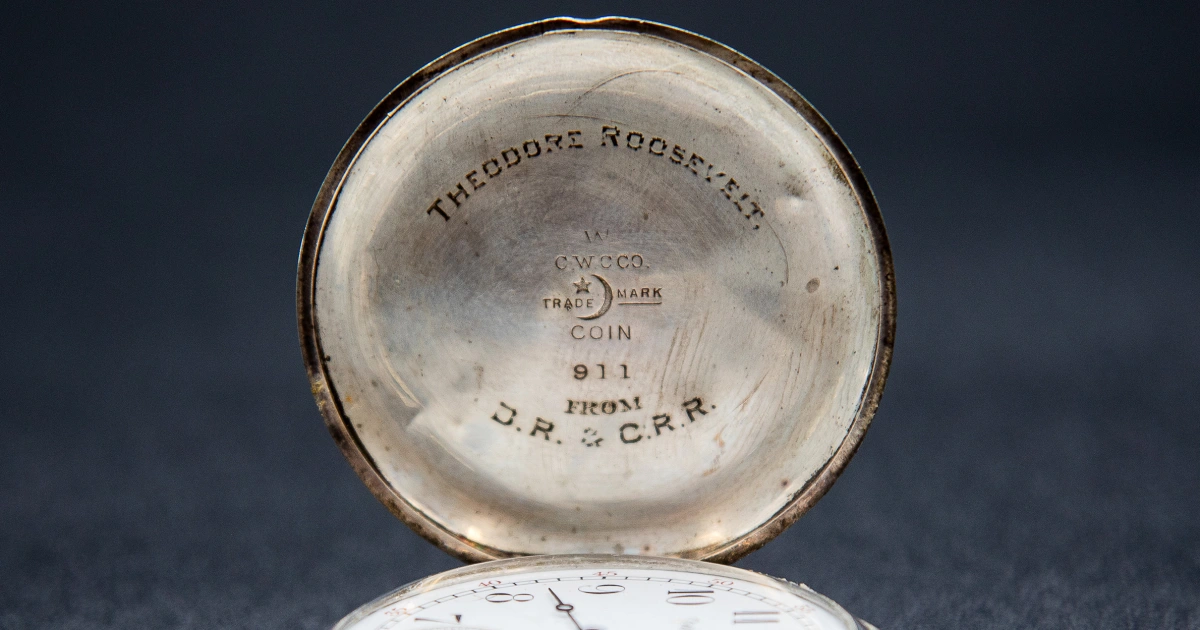Theodore Roosevelt’s pocket watch, a cherished gift from his sister and her husband, resurfaced in 2024 after decades of being lost. Stolen in 1987 from his inaugural historic site in Buffalo, New York, the watch’s reappearance sparked renewed interest not only in its history but also in its potential value. While initially valued at “less than $1,000” at the time of its theft, experts believe the historical significance of Roosevelt’s timepiece could place its worth considerably higher.
Uncovering a Legacy: The Significance of the Markings
More than just a timekeeping device, Roosevelt’s watch bears silent witness to key moments in his life. Numerous inscriptions from repairs and tune-ups throughout its history offer glimpses into its journey alongside the 26th President. Could these markings hold clues to the watch’s presence during Roosevelt’s famous charge up San Juan Hill or his daring explorations of the Amazon?
Experts are meticulously deciphering these intricate inscriptions, hoping to unlock further secrets. Some markings remain enigmatic, while others clearly reveal details about the watch’s maintenance and potential repairs. This process provides valuable insight not only into the watchmaking practices of the past but also into the life and times of one of America’s most fascinating presidents.
A Presidential Timepiece: Determining the Watch’s Worth
The rediscovery of Roosevelt’s pocket watch offers a compelling glimpse into the 26th President’s life, but it also begs the question: how do you put a price tag on a piece of American history? The watch’s intrinsic value is deeply intertwined with Roosevelt’s legacy. It represents a tangible link to his presidency, explorations, and the Progressive Era, making its monetary value just one facet of its overall significance.
Several factors contribute to the potential value of this historical artifact:
- Provenance: Gifted by Corinne Roosevelt Robinson and Douglas Robinson to Theodore Roosevelt in 1898, the watch carries significant sentimental value.
- Historical Context: The watch accompanied Roosevelt during pivotal events, including the Battle of San Juan Hill, his Amazon explorations, and his presidency (1901-1909).
- Rarity & Condition: The watch’s unique history and its current condition after decades of being missing will significantly influence its appraisal.
While the watch’s initial valuation at the time of its theft provides some context, it’s likely outdated. To determine its true worth in today’s market, experts would consider factors such as:
- Maker/Brand: The watchmaker’s reputation and the brand’s prestige play a crucial role in determining value.
- Materials & Craftsmanship: The use of precious metals, intricate engravings, or unique design elements can significantly impact the watch’s worth.
- Historical Significance: The watch’s direct connection to Theodore Roosevelt and its presence during significant historical events make it a highly desirable collector’s item, potentially driving its value beyond traditional appraisal methods.
What the Numbers and Markings Inside Your Pocket Watch Reveal
Have you ever wondered about the mysterious numbers and symbols engraved inside your own pocket watch? These aren’t random markings; they’re clues to its unique journey through time. Unlocking these secrets can connect you to the watch’s maker, reveal its age, and perhaps even whisper tales of its previous owners.
Decoding the Language of Time: Common Pocket Watch Markings
- Serial Numbers: Like a fingerprint, a serial number identifies your pocket watch. Located on the movement inside the case, it can often be used to pinpoint the watch’s manufacturing year and origin using online databases like the Pocket Watch Database.
- Hallmarks: These tiny symbols, often found on precious metal cases, are like stamps of authenticity. They indicate the purity and type of metal used. For example, a “14k” or “18k” hallmark signifies a gold case and its karat value, a measure of its gold content.
- Watchmaker’s Marks: Peek inside the watch’s inner workings, and you might find a series of letters, numbers, or symbols etched among the gears. These are the watchmaker’s marks, personal “signatures” left by the skilled artisans who assembled, repaired, or serviced the watch throughout its life.
- Other Inscriptions: Your pocket watch might also bear additional markings, such as its grade (a quality rating) or model name, which often hints at special features. And if you’re fortunate, you might even discover engraved initials or dates, offering tantalizing glimpses into the lives of previous owners.
“F” and “S”: Fine-Tuning Time in a Bygone Era
Among the many intriguing inscriptions found on antique pocket watches are the letters “F” and “S”, often located near the time adjustment mechanism. In an era before smartphones and atomic clocks, these markings played a vital role in maintaining the accuracy of these intricate timepieces.
“F” stands for “Fast,” and “S” stands for “Slow.” If a pocket watch was running ahead of time, the owner or a watchmaker would gently turn the adjustment key towards the “S” to slow it down. Conversely, a nudge towards the “F” would speed up a lagging timepiece. This delicate dance of precision allowed for fine-tuning, ensuring the watch kept time as accurately as possible.
These seemingly simple markings offer a fascinating glimpse into a time when pocket watches were not mere accessories but essential tools for navigating a world governed by the steady march of time.
Identifying Your Own Pocket Watch: A Journey of Discovery
Discovering an old pocket watch can feel like unearthing a hidden treasure, especially if you can unravel its mysteries. Here’s how to begin your own identification journey:
- Examine the Case: Look for any visible markings on the outside of the case, such as brand names, logos, or decorative patterns. These can provide initial clues about the watch’s maker and era.
- Open the Case: Carefully open the watch case (usually by pressing a small lever or button) to reveal the movement inside. Handle the watch with care, as the internal mechanisms are delicate.
- Locate the Serial Number: The serial number is usually engraved on the movement itself, not on the case. It’s a unique code that can help determine the watch’s manufacturing year, model, and sometimes even its grade or jewel count.
- Consult Online Resources: Websites like the Pocket Watch Database and PM Time Service can be invaluable tools. Entering the serial number or other identifying markings into their databases can often yield detailed information about your watch.
- Seek Expert Advice: If you encounter challenges deciphering markings or need help authenticating your pocket watch, consult a reputable antique watch expert or appraiser. They can provide valuable insights and ensure you’re getting accurate information.
Preserving History, One Tick at a Time
Whether you’re captivated by the historical significance of Teddy Roosevelt’s rediscovered timepiece or intrigued by the secrets hidden within your own antique pocket watch, these intricate mechanisms offer more than just a glimpse into the past. They remind us of an era when craftsmanship and precision were paramount, and they connect us to the stories of those who relied on these remarkable devices to navigate their world.
- SYBAU See You Baby Meaning: Gen Z Slang Evolves - July 1, 2025
- Unlock Your Inner Youth: Lifestyle Secrets for a Vibrant Life - July 1, 2025
- Decode SYBAU Meaning: Gen Z Slang Explained - July 1, 2025






